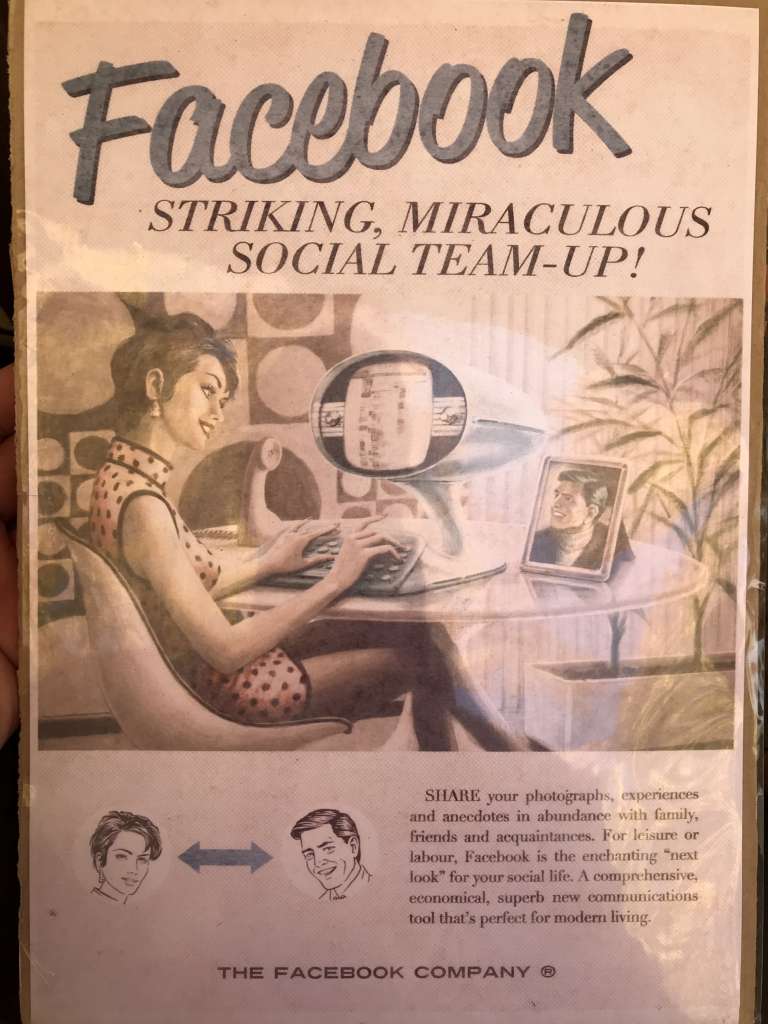“Just for clarification.” Before the professor left the room, I went to ask him,” So the project, the post for next week is that we need to include one photo in our blog post, right?” “I don’t remember I said a ‘photo'” He replied and smiled.
Images. Photos. Of course they are different. I thought to myself. Images are like an umbrella term and photographs are just part of it. Case solved. But do photographs have any uniqueness that an ‘image’ doesn’t share? And during this week this idea just haunted me. To figure this out, I thus, decided to go on a trip in Belgium (Of course these two things are irrelevant, I just wanted to go on a trip to Belgium and that’s it). On Saturday I was in Ghent, passing by Rozenhoedkaai and there was a small vintage market along the bank. Beautiful antiques, vintage rings and pictures, nostalgia handicrafts. Among these, one little sheet laid aside on the corner of the table caught my attention.

It was a beautiful paper ad. With the colors on it fading a bit, it captured that nostalgic taste and aura with on the surface an main illustration, few little ones and several lines of captions. After I went back, I surfed online and found out it was actually a ‘fake ad’ which is not created not by the Facebook Company. It was in 2010, Sao Paulo ad agency Moma Propoganda created a series of retro future ads for Facebook, Youtube, and Skype as part of the “Everything Ages Fast” ad campaign for Maximidia Seminar. And of course there is a lot of things could be discussed and explored in this delicately well designed ad such as the word choices and slogans, the design itself of this retro future ads, the motif of creating such a work, the image it selected or even advertising or marketing strategies implied in this ad, etc. These are just good. But questions I had at that time were : after I took a photo of an image, how should I define this photo? Is it more photo or is it more ‘image’? Undoubtedly, it is a ‘photo’ which I just photoed through my iphone 7 and it is stored in the ‘photos’ section right now. But could I use the word ‘image’ here and now describe this photo? Or maybe this word ‘image’ could not define ‘photographs’ to some degree? Does this photo carry some unique characteristics that an image this term or this idea does not possess?
An image, based on the definition on Vocabulary.com website, “(…) has its roots in the Latin word imitari, meaning “to copy or imitate . Images come in various forms — portraits, photographs, paintings, and sculptures. ” But in my opinion, an ‘image’, like a painting or illustration on this ad, shared a completely different point of view from photographs in the relationship to the reality. To be more specific, the distance between the reality to an image and to a photograph is different.
Images such as paintings or illustrations are just “interpretation of the real (Susan Sontag, 1997)”. In other words, they are not real. When we look at a portrait, people know the figure in the portrait is fundamentally different to the real person in the real life. And it is this inferential possibility makes images something powerful and fascinating. We fill the distance between the reality and images with imagination and interpretation. In other words, it is the symbolic meanings conveyed through images that is powerful. In contrast, a photograph is not only an image, but also a trace, something “directly stenciled off the real, like a footprint or a death mask (Susan Sontag, 1997)”. The distance between a photograph and the reality is absolutely close. At the moment I took that picture, my camera captured not only a visual image but also created an inferential relationship between me and the present (in other words, the past) which included the sunlight of the day, the temperature and the humidity, people I talked to in the hostel and waffles I bought for lunch. And this inferential relationship is not the same thing how people connect a painting or an illustration, an image, to the present. It seems to me with photographs, I could directly possess the present(the past).
Both as an information storage, a tool of record, we this generation prefer to get used to taking pictures instead of carrying our painting tools and a piece of canvas all the time. But maybe we should still be aware of we live in a world still consists of not just photographs but bunches of images as well. Or maybe not, I am bad at drawing.


While a photo might look like it is closer to real life than a painting, I could argue that the two are both as close to reality. When making a photo, your camera distributes light on a film roll, just like a painter distributes paint on a canvas. The difference, however, is that the camera does this more accurately, by directly copying reality. but, accuracy is not the same as reality. I don’t think something is more an image if it imitates better. A photo might imitate reality very closely, but a painting can imitate more than reality; it also imitates the fantasy of the painter. Image is an umbrella term for all types of pictures. The term can therefore be closer to reality, but also much further from reality.